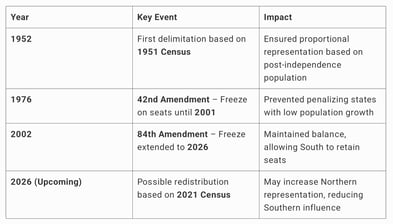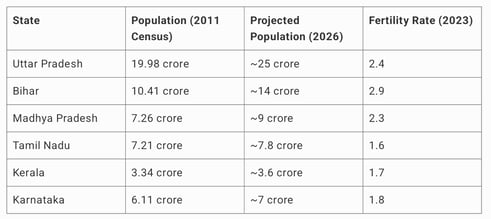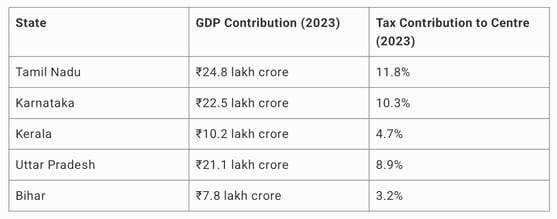Delimitation and the Future of Parliamentary Representation in India
The upcoming 2026 delimitation exercise has sparked political unrest across India, particularly in Southern states, which fear a reduction in their representation in the Lok Sabha due to their lower population growth rates. Meanwhile, Northern states, which have witnessed higher fertility rates, stand to gain more seats, potentially shifting political power in their favor.
This raises critical questions:
Should parliamentary representation be purely population-based?
How can we prevent the political marginalization of states that have controlled population growth?
Can an alternative model balance representation with economic and governance performance?
To answer these, we must examine historical trends, current demographic shifts, constitutional provisions, political reactions, and alternative models for a balanced solution.
Understanding Delimitation: Constitutional and Historical Background
1. Constitutional Basis of Delimitation
The Delimitation Commission of India is a statutory body responsible for redrawing the boundaries of parliamentary and assembly constituencies to reflect population changes. Article 82 of the Indian Constitution mandates that after every Census, parliamentary seats should be adjusted accordingly.
However, political concerns led to a freeze on seat allocation in 1976, which was later extended to 2026 through the 84th Constitutional Amendment (2002). This freeze protected the representation of states that controlled their population, mainly benefiting Southern states.
2. Historical Perspective on Delimitation in India
With 2026 nearing, the Southern states argue that simply relying on population-based seat allocation will unfairly reduce their influence in national policymaking.
The North-South Divide: Demographic and Political Concerns
1. Unequal Population Growth Trends
Population Growth Trends (2011 vs. 2026 Projections)
Key Observations:
Northern states (UP, Bihar, MP) are experiencing significant population growth, increasing their share in India’s total population.
Southern states (Tamil Nadu, Kerala, Karnataka) have fertility rates below replacement levels, meaning their populations are stabilizing or declining.
This means that under a population-based seat redistribution model, North India will gain more Lok Sabha seats, shifting political influence away from the South.
2. Projected Redistribution of Lok Sabha Seats Post-Delimitation
Implications:
Southern states may lose seats, despite being economic and governance leaders.
Policies could become more focused on the North, neglecting the South’s interests.
A shift in political dominance towards Hindi-speaking states, reducing linguistic diversity in national policymaking.
3. Economic Contribution vs. Political Representation
Should economic contribution play a role in seat allocation?
Southern states argue that their higher economic contributions should be factored into representation, as they fund a disproportionate share of national development.
Comparative Analysis: How Other Countries Handle Representation Disparities
1. United States (House of Representatives Model)
The US redistributes House seats every 10 years based on Census data, but states with slower population growth have mechanisms like:
Equal representation in the Senate, where each state gets 2 senators.
Federal funding based on economic contribution, preventing unfair resource allocation.
2. Canada (Balanced Representation Model)
Canada follows a hybrid model, where:
Representation is adjusted for population, but
Smaller provinces receive additional seats to maintain regional balance.
3. Germany (Mixed Representation Model)
Germany uses a proportional system where:
Seats are based on population, but
Governance and economic factors are also considered.
Could India adopt a similar model?
A Viable Strategy for Equitable Representation
1. A Hybrid Representation Model
A balanced approach should factor in:
50% seats based on population (to ensure proportional representation).
30% seats based on economic contribution (to reward states for financial stability).
20% seats based on governance indicators (like Human Development Index, literacy, health infrastructure).
2. Expanding the Lok Sabha
Instead of reducing Southern seats, India could expand the total number of Lok Sabha seats from 543 to 600+, ensuring that no state loses representation.
3. Strengthening the Rajya Sabha
To counterbalance Northern dominance, the Rajya Sabha could be:
Given a greater role in financial decision-making.
Expanded with more seats for smaller states.
4. Rewarding Population Control Efforts
A "Demographic Success Fund" can be introduced to financially reward states that have successfully controlled their population.
Conclusion: Towards an Equitable Federal Democracy
The 2026 delimitation exercise must be conducted carefully and fairly, ensuring that India’s democracy remains balanced.
A hybrid representation model will prevent unfair dominance by any region.
Expanding Lok Sabha seats can ensure no state loses influence.
Recognizing economic contribution and governance performance will make representation fairer.
By adopting such an approach, India can protect federal unity, respect regional diversity and uphold the democratic principle of fairness.








